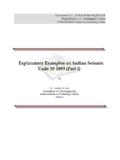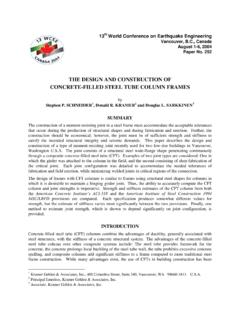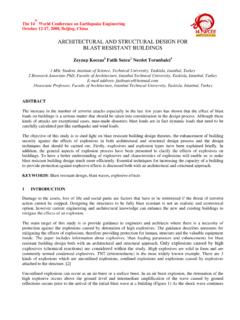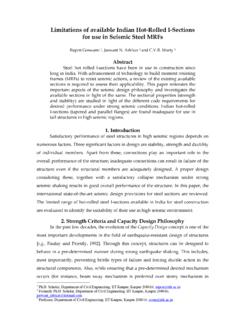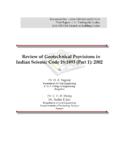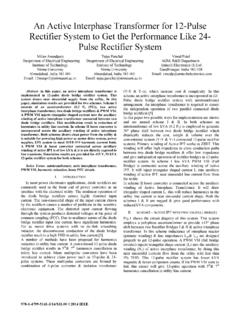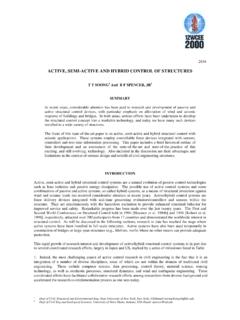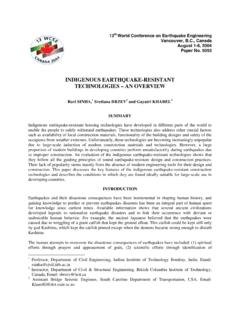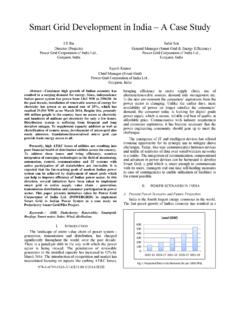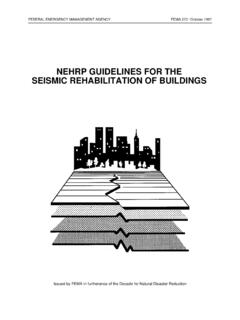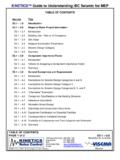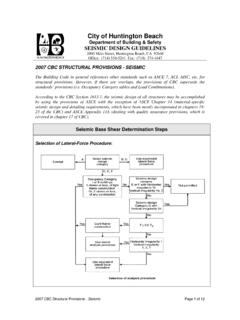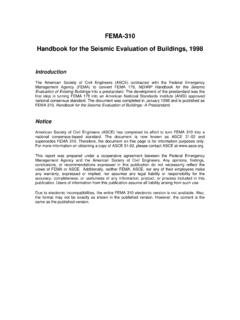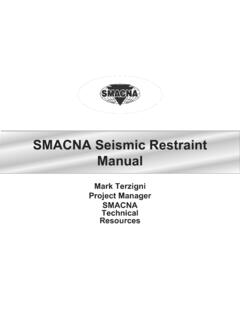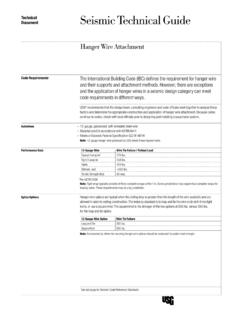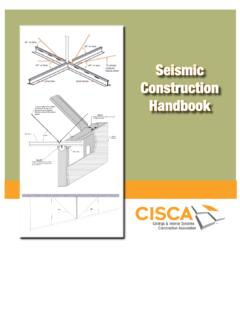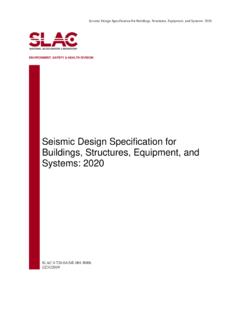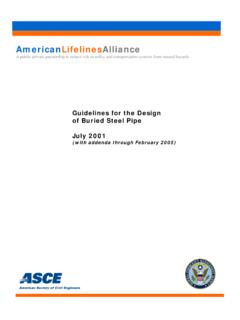Transcription of for SEISMIC DESIGN OF
1 IITK-GSDMA guidelines for SEISMIC DESIGN OF LIQUID STORAGE TANKS Provisions with Commentary and Explanatory Examples Indian Institute of Technology Kanpur Gujarat State Disaster Management Authority October 2007 NATIONAL INFORMATION CENTER OF EARTHQUAKE ENGINEERING Other IITK-GSDMA guidelines Available from NICEE : IITK-GSDMA guidelines for SEISMIC DESIGN of Buried Pipelines IITK-GSDMA guidelines for Structural Use of Reinforced Masonry IITK-GSDMA guidelines for SEISMIC DESIGN of Earth Dams and Embankments IITK-GSDMA guidelines for SEISMIC Evaluation and Strengthening of Existing Buildings IITK-GSDMA guidelines on measures to Mitigate Effects of Terrorist Attacks on Buildings Please see back cover for current list of NICEE publications available for distribution.
2 IITK-GSDMA guidelines for SEISMIC DESIGN OF LIQUID STORAGE TANKS Provisions with Commentary Prepared by: Indian Institute of Technology Kanpur Kanpur With Funding by: Gujarat State Disaster Management Authority Gandhinagar October 2007 NATIONAL INFORMATION CENTER OF EARTHQUAKE ENGINEERING Indian Institute of Technology Kanpur, Kanpur (India) ii The material presented in this document is to help educate engineers/designers on the subject. This document has been prepared in accordance with generally recognized engineering principles and practices. While developing this material, many international codes, standards and guidelines have been referred. This document is intended for the use by individuals who are competent to evaluate the significance and limitations of its content and who will accept responsibility for the application of the material it contains.
3 The authors, publisher and sponsors will not be responsible for any direct, accidental or consequential damages arising from the use of material content in this document. Preparation of this document was supported by the Gujarat State Disaster Management Authority (GSDMA), Gandhinagar, through a project at Indian Institute of Technology Kanpur, using World Bank finances. The views and opinions expressed in this document are those of the authors and not necessarily of the GSDMA, the World Bank, or IIT Kanpur. The material presented in these guidelines cannot be reproduced without written permission, for which please contact NICEE Coordinator. Published by: Coordinator National Information Center of Earthquake Engineering Indian Institute of Technology Kanpur Kanpur 208 016 (India) Email: Website: ISBN 81-904190-4-8 iii Participants Prepared by: Sudhir K.
4 Jain, Indian Institute of Technology Kanpur O R Jaiswal, Visvesvaraya National Institute of Technology, Nagpur Reviewed by: P K Malhotra, FM Global, USA L K Jain, Structural Consultant, Nagpur Additional review comments by: A R Chandrasekaran, Hyderabad K K Khurana, IIT Roorkee Rushikesh Trivedi, VMS Consultants, Ahmedabad GSDMA Review Committee: V. Thiruppugazh, GSDMA, Gandhinagar Principal Secretary, UDD, Gandhinagar Sr. Town Planner, Gandhinagar Secretary, Roads and Buildings, Gandhinagar A. S. Arya, Ministry of Home Affairs, New Delhi Alpa Sheth, Vakil Mehta Sheth Consulting Engineers, Mumbai iv v FOREWORD The earthquake of 26 January 2001 in Gujarat was unprecedented not only for the state of Gujarat but for the entire country in terms of the damages and the casualties.
5 As the state came out of the shock, literally and otherwise, the public learnt for the first time that the scale of disaster could have been far lower had the constructions in the region complied with the codes of practice for earthquake prone regions. Naturally, as Gujarat began to rebuild the houses, infrastructure and the lives of the affected people, it gave due priority to the issues of code compliance for new constructions. SEISMIC activity prone countries across the world rely on codes of practice to mandate that all constructions fulfill at least a minimum level of safety requirements against future earthquakes. As the subject of earthquake engineering has evolved over the years, the codes have continued to grow more sophisticated. It was soon realized in Gujarat that for proper understanding and implementation, the codes must be supported with commentaries and explanatory handbooks.
6 This will help the practicing engineers understand the background of the codal provisions and ensure correct interpretation and implementation. Considering that such commentaries and handbooks were missing for the Indian codes, GSDMA decided to take this up as a priority item and awarded a project to the Indian Institute of Technology Kanpur for the same. The project also included work on codes for wind loads (including cyclones), fires and terrorism considering importance of these hazards. Also, wherever necessary, substantial work was undertaken to develop drafts for revision of codes, and for development of entirely new draft codes. The entire project is described elsewhere in detail. The Gujarat State Disaster Management Authority Gandhinagar and the Indian Institute of Technology Kanpur are happy to present the IITK-GSDMA guidelines on SEISMIC DESIGN of Liquid Storage Tanks to the professional engineering and architectural community in the country.
7 It is hoped that the document will be useful in developing a better understanding of the DESIGN methodologies for earthquake-resistant structures, and in improving our codes of practice. GSDMA, Gandhinagar IIT Kanpur vi vii PREFACE Liquid storage tanks are commonly used in industries for storing chemicals, petroleum products, etc. and for storing water in public water distribution systems. Importance of ensuring safety of such tanks against SEISMIC loads cannot be overemphasized. Indian SEISMIC code IS 1893:1984 had some very limited provisions on SEISMIC DESIGN of elevated tanks. Compared to present international practice, those provisions of IS 1893:1984 are highly inadequate.
8 Moreover, the code did not cover ground-supported tanks. In 2002, revised Part 1 of IS 1893 has been brought out by the Bureau of Indian Standards (BIS). The other parts, one of which will contain provisions for liquid storage tanks, are yet to be brought out by the BIS. In the above scenario, to assist the designers for SEISMIC DESIGN of liquid storage tanks, it was decided to develop the present document under the project Review of Building Codes and Preparation of Commentary and Handbooks assigned by the Gujarat State Disaster Management Authority, Gandhinagar to the Indian Institute of Technology Kanpur in 2003. The provisions included herein are in line with the general provisions of IS1893 (Part 1): 2002 and hence should pose no difficulty to the designers in implementation.
9 To facilitate understanding of the provisions, clause-by-clause commentary is also provided. Further, six explanatory solved examples are provided based on the provisions of these guidelines . This document was developed by a team consisting of Professor Sudhir K Jain (Indian Institute of Technology Kanpur) and Professor O R Jaiswal (Visvesvaraya National Institute of Technology, Nagpur). Dr P K Malhotra (FM Global, USA) and Sri L K Jain, (Structural Consultant, Nagpur) reviewed several versions of this document and provided valuable suggestions to improve the same. The document was also placed on the web site of National Information Centre of Earthquake Engineering ( ) for comments by the interested professionals and some useful suggestions were provided by Professor A R Chandrasekaran (Hyderabad), Prof K K Khurana (IIT Roorkee), and Sri Rushikesh Trivedi (VMS Consultants, Ahmedabad).
10 Sri Amit Sondeshkar and Ms Shraddha Kulkarni, Technical Assistants at VNIT Nagpur, assisted in development of the solved examples and various graphs and figures of this document. It is hoped that the designers of liquid retaining tanks will find the document useful. All suggestions and comments are welcome and should be sent to Professor Sudhir K Jain, Department of Civil Engineering, Indian Institute of Technology Kanpur, Kanpur 208 016, e-mail: SUDHIR K. JAIN INDIAN INSTITUTE OF TECHNOLOGY KANPUR OCTOBER 2007 viii ix CONTENTS PART 1: Provisions and Commentary 0. 1 1. 6 2. REFERENCES .. 7 3. SYMBOLS .. 8 4. PROVISIONS FOR SEISMIC 12 SPRING MASS MODEL FOR SEISMIC 12 Ground Supported Tank.
